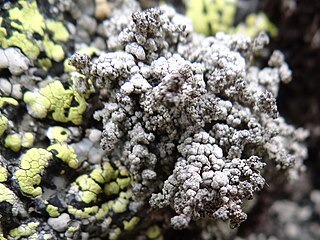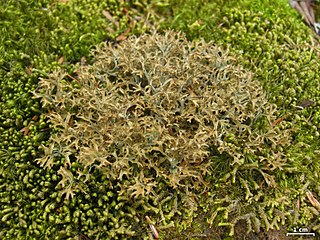Endococcus is a genus of lichenicolous (lichen-dwelling) in the family Lichenotheliaceae. It has 44 species. The genus was circumscribed by the Finnish botanist William Nylander in 1855. Although at least one source places the genus in the Verrucariaceae, a 2016 study of the type species, Endococcus rugulosus, determined that it should instead be placed in the family Lichenotheliaceae of the order Dothideales; this classification echoes a placement proposed in 1979 by David Hawksworth.

Stereocaulon alpinum is a species of fungus belonging to the family Stereocaulaceae. It is similar to Stereocaulon paschale but differs from it in containing cyanobacteria of the genus Nostoc while S. paschale contains cyanobacteria of the genus Stigonema, which have a darker colour than Nostoc.
Lichenopeltella cetrariae is a species of fungus belonging to the class Dothideomycetes. It has been found growing on Cetraria aculeata in Hrútey near Blönduós, Iceland and on Cetraria laevigata in Bulgan district, Mongolia and Toyama prefecture, Japan. In Japan, it has also been reported growing on Flavocetraria cucullata in Yamanashi prefecture and Nagano prefecture.
Lichenopeltella uncialicola is a species of fungus belonging to the class Dothideomycetes. The species was discovered in Iceland in 2010 where it was found growing on Cladonia uncialis. Since then, it has been found on a different host species, Cladonia rangiferina, in North-Korea, Italy Austria, and Greenland.
Lichenoconium pyxidatae is a species of lichenicolous fungus belonging to the class Dothideomycetes. It has a Holarctic distribution being found in Alaska and various parts of Russia, including Siberia, Franz Josef Land, Novaya Zemlya and Wrangel Island.
Nanostictis caucasica is a species of lichenicolous (lichen-eating) fungus in the family Stictidaceae. It is known to occur only in a single locality in the North Caucasus region of Southern Russia, where it grows parasitically on the foliose lichen Parmelia sulcata.
Clypeococcum bisporum is a species of lichenicolous (lichen-eating) fungus in the family Polycoccaceae. It is found in the Russian Far East, in Mongolia, and from northwest Alaska, where it grows parasitically on lichens from the genera Cetraria and Flavocetraria.
Neoechinodiscus kozhevnikovii is a species of lichenicolous (lichen-eating) fungus in the order Helotiales. It is known to occur in Russia, Austria, and Switzerland, where it grows parasitically on lichens in genus Cetraria.

Stereocaulon vesuvianum is a species of snow lichen belonging to the family Stereocaulaceae.

Stereocaulon tomentosum is a species of snow lichen belonging to the family Stereocaulaceae.

Stereocaulon saxatile is a species of snow lichen belonging to the family Stereocaulaceae.
Stereocaulon botryosum is a species of snow lichen belonging to the family Stereocaulaceae.
Stereocaulon myriocarpum is a species of snow lichen belonging to the family Stereocaulaceae.
Stereocaulon grande is a species of snow lichen belonging to the family Stereocaulaceae.
Cercidospora stereocaulorum is a species of lichenicolous fungus in the genus Cercidospora but it has not been assigned to a family. It is known to parasitise lichens of the genus Stereocaulon.
Sphaerellothecium araneosum is a species of lichenicolous fungus in the family Phyllachoraceae.
Polycoccum laursenii is a species of lichenicolous fungus in the family Polycoccaceae. It was first described as a new species in 2004 by Russian mycologist Mikhail Petrovich Zhurbenko. It is found in Alaska and in Russia.
Arthonia stereocaulina is a species of lichenicolous fungus in the family Arthoniaceae.
Endococcus nanellus is a species of lichenicolous fungus in the order Dothideales. It is known from Alaska, Canada, Greenland, Hawaii, Japan, Russia, South-Korea, and Kazakhstan.

Cetraria laevigata is a species of ground-dwelling, fruticose (bushy) lichen in the family Parmeliaceae. It was formally described as a new species by Russian lichenologist Kseniya Aleksandrovna Rassadina in 1943. In North America, it is commonly known as the striped Iceland lichen.




